Creating the Department of Veterans Services
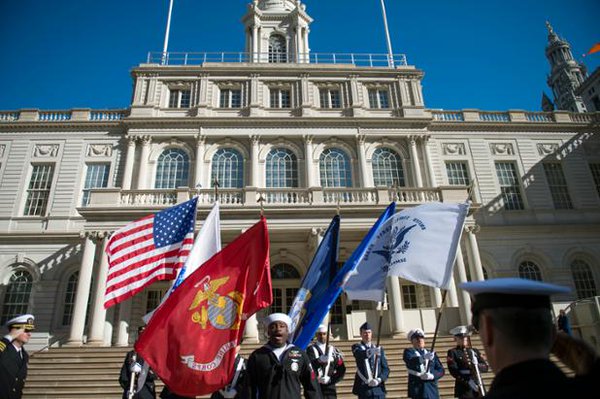
armed services flags at city hall (photo via @BilldeBlasio)
As we head into Veterans Day, military veterans and their families received historic news last week when the de Blasio administration and the City Council, under the leadership of Speaker Mark-Viverto and Council Member Eric Ulrich, chair of the veterans committee, came to an agreement on creating a new Department of Veterans Services.
This new department will replace the Mayor’s Office of Veterans Affairs (MOVA), creating an agency with more resources better suited to help the city’s large and diverse veterans community find and access resources. New York City will, of course, become the largest municipality in the country to have established an agency solely dedicated to veterans and their family members.
Most importantly, though, creating this new department will ensure that city efforts to help veterans will be properly funded every year, while moving city contracts awarded to local veteran service providers at a quicker pace, instead of through other city agencies more unfamiliar with the community’s needs.
However, this didn’t happen in a vacuum and it took a whole lot of work to accomplish. And, even now that it is happening, there is still much work to do.
From the beginning the administration seemed against the idea of a new department, with MOVA Commissioner Loree Sutton being non-committal on the bill at a hearing in January and Mayor de Blasio stating to reporters: "I have never been convinced that turning an office into a department in any subject matter is really the way to get things done best.”
Their opposition was confirmed in May when Commissioner Sutton wrote a Daily News op-ed in which she came out against the proposal, saying that it would lead to “costly duplication of city services and put the office at a greater remove from City Hall.” Though it was not exactly shocking to see, coming from the commissioner – who is supposed to be the community’s top government “advocate” - this didn’t sit well with the city veterans.
And then came the mayor’s appointment of Veterans Advisory Board members, which set in motion a spring and early summer of disappointment and anger from veterans on a number of issues and led many in the community to believe that there was zero traction on veterans issues at City Hall. However, the administration appeared to make up for these issues in late June when the new fiscal year 2016 budget was approved and veterans saw a significant increase and commitment from the city.
However, by then damage had been done and there was still no new department to help improve resources available to the city’s veterans. Along with that substantive problem, there was also poor messaging on the administration’s part. As the Mayor recently said to the Daily News editorial board, “I think there is a gap between reality and perception and I have to constantly take responsibility. If I got all this product and I’m not making it clear enough to people, of course that’s on me.”
Meanwhile, Council Member Ulrich was whipping votes and continuing his push for the bill – slowly taking the time to move the legislation along by building a coalition of veterans and advocates from throughout the five boroughs, holding hearings on the legislation while working to get other Council members to sign on and, essentially, being patient and flexible with the administration.
The support of Speaker Mark-Viverito was of course key, and with enough sponsors to override a possible de Blasio veto, Council Member Ulrich and his colleagues were able to force the mayor's hand. His decision to back the bill also seems to have come as he eyed Veterans Day and the need to do something significant to show the community he is serious about supporting those who have given so much.
Still, Council Member Ulrich surely negotiated well, and we don’t know what he may have had to offer in order to come to a final deal.
Now, here we are. A historic victory that might possibility be the greatest piece of legislation for veterans in New York City history. But is this the end? No. This new department will change the way we see the city operate in helping veterans and their family members, but there are still many issues to work on, including ensuring that more city contracts are awarded to veteran-owned businesses, for example. And, the new department must be organized and run effectively, helping veterans and their family members access education, health care, and employment resources.
It is essential, of course, that Mayor de Blasio has come around to help make this happen, and we look forward to celebrating with him at the bill-signing. First, we will celebrate with and thank Speaker Mark-Viverito, Council Member Ulrich, the rest of the City Council, and Public Advocate Letitia James.
Elected officials are moving this legislation, with its roots in the advocacy and the service of veterans and our allies. John Rowan, Lee Covino, Paul Narson, Jason Hansman, Oswaldo Pereira, Tireak Tulloch, Paul Rieckhoff, Kristen Rouse, Ryan Graham, Fang Wong, Paul Schottenhamel and Redmond Haskins all contributed significantly to this work and make our community strong.
We also cannot forget Pat Toro and Ed Daniels, who have passed away but were important in making this happen. As with others we have lost, we remember them as we go forward with this work, ensuring that public policy honors the sacrifice made by our military veterans and their families.
***
Joe Bello served 11 years in the U.S. Navy/Naval Reserve and has been a veterans advocate in New York City for two decades. He is the founder of NY MetroVets.
Sheldon Silver Trial Recalls Earlier Legislative Leaders Accused of Corruption
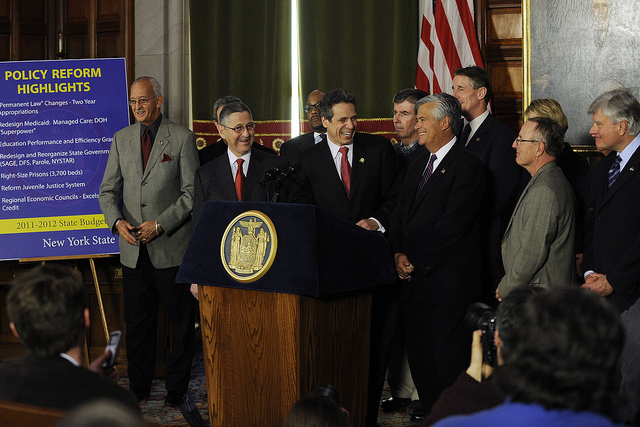
Silver, Cuomo, Skelos (photo: the governor's office on flickr)
The trial of former Assembly Speaker Sheldon Silver has begun in New York City with a federal prosecutor alleging he made $5 million through kickbacks from developers seeking legislative favors and other schemes. "Year after year, Sheldon Silver was on the take," said U.S. Attorney Carrie Cohen, alleging a pattern of "power, greed and corruption." Silver's counsel countered that the former Assembly leader's conduct was "legal and normal." The trial is expected to last six weeks.
Before it is over, former Senate Majority Leader Dean Skelos will go to trial on charges of extortion and soliciting bribes.
The charges facing both men are substantive and serious. Silver's charges carry a potential penalty of 130 years in prison.
Will Silver and Skelos be convicted? If they are, will they be sent to prison? The historical record may give both men cause for hope.
Former Senate Majority Leader Joseph L. Bruno was indicted by federal authorities for wire and mail fraud and other corrupt actions in 2009. Five years of trials, convictions, appeals, and challenges to the constitutionality of the laws that were the basis of prosecution resulted in acquittal. Bruno held a press conference to declare he had been completely exonerated and that the whole thing had been "persecution, not prosecution." New York taxpayers wound up footing most of Bruno's legal bills because state law allows officials to be reimbursed for "reasonable" legal fees if they are acquitted of crimes pertaining to their official duties.
One-time Assembly Speaker Melvin Miller and his law partner were convicted in 1991 of federal charges of cheating legal clients out of some of the profits from investments in cooperative apartments in New York City. The charges were unrelated to Miller's legislative work but the conviction meant automatic expulsion from the legislature. Miller was sentenced to community service which he performed at the Henry Street and University Settlements in New York City, working on mental health and other problems. Two years later, the conviction was overturned on appeal. Miller's actions "may not have been a model of candor and disclosure," the court said, but they did not constitute crimes. Miller decided not to run for office again but continued his legal practice and also worked as a lobbyist.
In 1975, Assembly Speaker Stanley Steingut and his son were indicted on charges that they had promised to assist a donor to the younger Stenigut's campaign for City Council to obtain an unsalaried city job in return for a $2,500 contribution. The exact nature of the position was never clear; press speculation was that it was an honorary deputy police commissioner or unsalaried adviser to the Civilian Complaint Review Board. The Steinguts apparently did not deliver the promised position and the aggrieved donor -- or someone else, it was never entirely clear -- complained to the district attorney. He brought charges under a seldom invoked statue that said an office holder could be charged with "corruptly using" his position in exchange for a benefit, usually cash. It was a shaky case at best.
Steingut denied the accusation and refused to resign as Speaker. Two years later, the Count of Appeals dismissed the indictment on the grounds that there was no evidence of "a materially harmful impact upon governmental processes." Steingut was elated but his vindication led to overconfidence and neglect of politics in his home district. In 1978, he lost his Assembly seat in a primary election.
Then-Assembly Speaker Perry B. Duryea and several others were indicted in 1973 for "vote siphoning." Prosecutors asserted that they set up a phony Liberal Party committee to print and distribute literature for Liberal candidates in marginal legislative districts in order to draw votes away from Democratic candidates, thereby aiding Republicans.
Duryea proclaimed his innocence and refused to step down as Speaker. The next year the charges were dismissed when the section of the election law requiring sponsors of political literature to identify themselves was ruled unconstitutional. Duryea believed the whole thing was a scheme by political opponents to derail his pursuit of the Republican gubernatorial nomination in 1974. Four years later, out from under the cloud of the voting scandal, he secured the nomination but lost the election to Governor Hugh Carey.
Senator Arthur Wicks of Kingston became majority leader in 1949 and, in 1953, also began serving as acting Lieutenant Governor after the incumbent resigned. Press investigative reports that fall disclosed that he had made several visits to Joseph Fay, a labor union leader imprisoned in Sing Sing prison for extortion. Wicks made a paid TV broadcast on Oct. 18, 1953, saying that he had once asked Fay's help "to see that [a union] jurisdictional fight terminated" and other times had asked him "to keep labor peace in my district."
Wicks compared the visits to Fay to the President negotiating with Communist leader Joseph Stalin -- unpleasant but necessary. That analogy didn't wash with Governor Thomas Dewey or most state senators. Wicks was never formally charged with wrongdoing but consulting with a felon at Sing Sing hardly seemed appropriate for one of the state's top officials. Dewey convinced him to resign as majority leader and acting Lieutenant Governor. But he held on to his Senate seat, and was re-elected in 1954.
In 1910, Senator Benn Conger accused Majority Leader Jotham P. Allds of having taken a bribe to kill a piece of legislation back in 1901, when both were serving in the Assembly. Allds proclaimed his innocence, the Senate investigated, and an eyewitness testified that he had seen Allds take a $1,000 bribe in Conger's presence. "I guess it's all right, Conger, it feels good!" Allds had said as he put the envelope with the bribe into his suit pocket. Allds resigned from the Senate just before a vote that had been scheduled to expel him. But he was never prosecuted.
The Senate investigation that unseated Allds also revealed that S. Frederick Nixon, Assembly Speaker from 1899 to 1905 had often taken bribes to advance or kill legislation. He was at the head of a corrupt system of "bill-killing and law-getting," in the words of a contemporary journal article. By 1910, though, Nixon was dead, so only his reputation was tarnished.
History suggests that neither party is more inclined to corruption than the other. Silver, Miller, and Steingut are Democrats; Skelos, Bruno, Duryea, Wicks and Allds, Republicans.
Silver has been speaker since 1994, the second longest tenured speaker in history, and some people have suggested that is too long, leading to arrogance and a sense of entitlement.
The longest tenured Speaker, Oswald D. Heck, a Republican from Schenectady, served from 1937 to 1959, beating Silver by a year. His longevity did not lead to ethics violations or corruption. In fact, he was one of the most effective and upright speakers in state history.
Heck described his political philosophy as "a hard and conservative attitude in economics and a gentle, understanding attitude in human relations." He pressured governors to hold the line on spending but he backed progressive labor and social reforms, including the first state civil rights law in the nation in 1945. The principles he espoused -- cost efficient but responsive government, bi-partisan approaches, and alignment of politics behind the public good -- are still good models. This suggests that longevity in a legislative leadership position does not necessarily result in lapsing into political corruption.
The case against Silver will turn on whether prosecutors can produce and explain evidence that the ex-speaker's maneuverings and deals rose to the level of criminal activities rather than an extreme form of routine Albany deal-making politics. "There are two sides to every story, and we haven't heard [Silver's] side" yet, wrote Mel Miller in a Wall Street Journal op-ed column earlier this year. That story is about to pour out.
Whatever the verdict, history will be made.
***
Dr. Bruce W. Dearstyne is the author of the book The Spirit of New York: Defining Events in the Empire State's History, published in 2015 by SUNY Press.
***
Have an op-ed idea or submission for Gotham Gazette? E-mail editor Ben Max: This email address is being protected from spambots. You need JavaScript enabled to view it.
Keeping New York Water Clean

Seneca Lake (photo via @NYGov)
Do you enjoy a pumpkin spice latte during the crisp fall weather? A warm cider, perhaps? No matter your drink of choice, it is ask risk of being more dangerous than delicious as Congress and federal courts have frozen the Clean Water Rule, instituted on August 28. The Clean Water Rule would have ensured that your beverages are clean and tasty, but officials are leaving us all vulnerable.
At the end of this summer, the U.S. Environmental Protection Agency's Clean Water Rule reinstated Clean Water Act protections to 28,785 miles of streams across New York and over 2 million nationwide that were previously open to pollution. This meant that drinking water for over 11 million New Yorkers, 55 percent of the state's population, was safe from the toxic chemicals that industry dumps into waterways.
The new Clean Water Rule finally gave the EPA the power and jurisdiction it needed to keep water clean and us healthy. From clean water advocates who dedicate their lives to this work to farmers, small business people, elected officials, and the citizens of neighborhoods across America, people from all over the country have campaigned to institute this rule. It is an issue that affects each and every one of us.
Clean drinking water is a basic right. Without clean water, not only does our quality of life decline, our economy slumps along with it. It is eye-opening to discover the importance clean water holds in everyday lives, and it is frightening to learn how much it is being threatened.
Big business, such as large-scale farming and oil and gas companies, have been fighting this rule since its enactment. It is upsetting that these businesses are willing to risk the lives of their consumers for short-term profits. The Senate recently sided with special interests by voting to dismantle the Clean Water Rule. President Obama has stated that he will veto their dangerous bill, and we need our senators who care about our public health to uphold this veto. Americans deserve to be able to swim, boat, eat fish, and drink water without worrying about the health repercussions of water pollution.
Luckily, New Yorkers have responsible and forward thinking officials. Senator Schumer is standing strong in his commitment to clean water and is standing guard against attempts to dismantle the Clean Water Rule in the budget process. A hero among members of Congress on this issue, Schumer must continue advocating for clean water and being an example for the rest of the Senate. As New Yorkers, we need to support his efforts and make our voices heard as loudly as those of the polluters.
***
Anubhuti Kumar is Media Intern at Environment New York, a statewide, citizen-funded advocacy organization working for the places we love and the environmental values we share. On Twitter: @EnvNY.
Prison Alternatives Enhance Public Safety & Must Be Left in Place
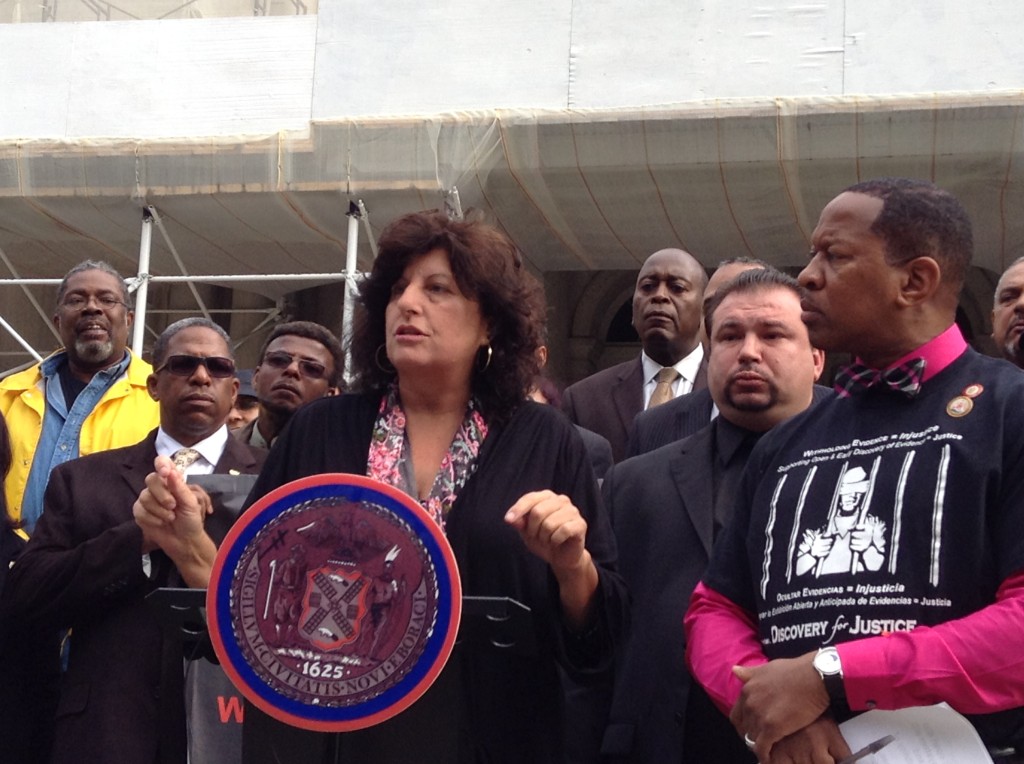
The author at a rally
As New Yorkers, we are all deeply saddened by the recent death of NYPD Officer Randolph Holder. But as we mourn and seek answers to this tragedy, we must not repeat the mistakes of past decades and allow retributive impulses to supersede evidence-based approaches to public safety.
People in drug diversion programs return to the community, as do 95 percent of people sent to prison. However, unlike incarceration, diversion successfully addresses some of the root causes of crime. Rolling back diversion programs that have increased public safety and lowered prison and jail populations would be a dangerous mistake and send a signal to policymakers across the country that New York is bound by the politics of fear.
As a public defender in Brooklyn for more than thirty years, I have seen firsthand the devastating effects of the combination of failed drug policies, disproportionate sanctions and mandatory minimums.
By the 1980s, it was becoming clear to public defenders, district attorneys, and judges alike that incarceration of poor people of color was not making our neighborhoods safer. Instead, it ensnared entire communities in an epidemic of criminal justice involvement, leaving untold numbers of New Yorkers—the vast majority low-income people of color—with the enormous burden of criminal records, in addition to the unmet mental health needs, untreated addiction, cyclical poverty, and multi-generational trauma that likely precipitated their arrests.
In Kings County we did not wait for reform of ineffective laws and decided to do something different— creating diversion programs beginning in the late 1980s and early '90s to allow defendants to enter drug and mental health treatment to address the conditions that prompted the criminal behavior in the first place. The theory was, and still is, that high quality diversion programs and treatment courts for the adjudication of cases for appropriate candidates would keep us safe, save money, and promote confidence in a troubled system. Support for these programs among politicians has varied over the years, but their success has always been validated by statistical evidence.
The point of diversion is public safety. We know that people who are given the opportunity to get clean, find stable housing, develop work skills, and avoid the collateral consequences of a conviction are much less likely to re-offend. In New York City, people who complete drug programs have a 36 percent recidivism rate, as compared to 54 percent for those sentenced to prison, jail, probation, or time served, according to a 2015 report by the Vera Institute of Justice.
To be sure, drug treatment and other court mandates can never address all of the reasons that people commit crimes. Likewise, because the success of these programs is contingent on defendants continuing to live in the community, there is an inherent risk that a small number of individuals will not comply with the mandates of the court. Incidents like Detective Holder's death, though tragic, are extremely rare. In fact, a 2000 study of diverted felony drug offenders showed that they pose no more of a risk to public safety than those traditionally prosecuted.
Brooklyn Defender Services handles over 45,000 cases a year; nearly 2,000 of our clients benefit from specialized treatment courts in Kings County annually. Two clients, Mark and John (names changed to protect their identities) have cases that are illustrative of the important role that alternatives to incarceration play in promoting public safety and helping people to improve their lives and those of their families and communities.
John, arrested in an undercover drug sale, has cognitive limitations. He accepted a conditional plea that included connection with services from Brooklyn Forensic Link, a program that assists severely mentally ill offenders each year with treatment and related transitional services. With the support of Brooklyn Forensic Link, he completed the terms of his conditional plea within six months and now receives much-improved access to services to help him navigate the city despite his disability.
Another client, Mark, was arrested for breaking into stores to steal money to support his heroin habit. Mark's case was transferred to drug court. He has already completed the inpatient portion of his treatment, is currently participating in outpatient treatment, now holds a job in construction, and recently became engaged to be married.
Their stories of success are repeated thousands of times each year. Yet I remember a time when Mark and John would have had no options other than incarceration, without the benefit of programming to prevent future contact with the criminal justice system.
Those who forget the past are doomed to repeat it. While we still have far to go, New York has taken important steps towards criminal justice reform. Safe and effective use of diversion programs began in Brooklyn and later served as the blueprint for reforming the Rockefeller Drug Laws in 2009. These programs reduce crime: arrests are down and fewer people are spending unnecessary time in jail or prison.
There is no doubt that the death of Randolph Holder deserves thoughtful pause. We are New Yorkers—thinkers and doers. We dishonor Officer Holder's service if we roll back hard-fought reforms that have made New York safer for everyone. The proposals urged thus far—fragmented bail reform, limiting access to diversion and adjustment of the sealing statutes—will not prevent future tragedies. Instead, they will hurt the thousands of New Yorkers who already suffer the most—poor people of color and the communities in which they live and work.
***
by Lisa Schreibersdorf, Executive Director of Brooklyn Defender Services. On Twitter @BklynDefenders.
***
Have an op-ed idea or submission for Gotham Gazette? E-mail editor Ben Max: This email address is being protected from spambots. You need JavaScript enabled to view it.
Wall Street Doesn’t Work for New York, Let’s Create a Bank that Will
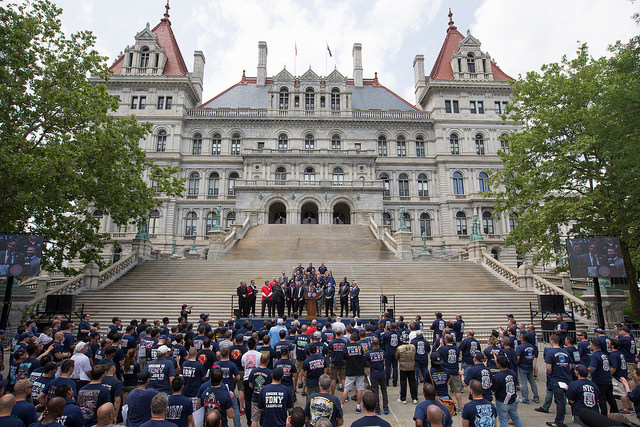
A rally at the capitol (photo: Governor's Office via flickr)
This summer treated New Yorkers to a spectacular display of the vulnerabilities of the New York region’s century-old subway system. Hardly a day passes without a rush hour social media meltdown because of delays and service interruptions. The MTA’s own data back this up: the authority is struggling to keep pace with historically high ridership while also upgrading the system.
The recent agreement struck between Governor Cuomo and Mayor de Blasio to fund the MTA five-year capital budget is encouraging, but it does not in any significant way address the agency’s failure to build and maintain infrastructure with cost-efficiency. The MTA will likely find much of the funding for the capital budget by taking on more debt.
In light of these struggles, recent (and upcoming) increases in subway fares should draw out the pitchforks -- or they would, if straphangers knew that most of the money doesn’t go to services for riders, but to paying MTA debt service, which has reached the size of whole national economies. According to the MoveNY Fair Plan, 17 percent of the MTA operating budget is spent on debt service. That’s equivalent to 47 cents of every MetroCard swipe -- and that number is rising.
Bringing MTA capital costs under control will require an overhaul of the agency’s organizational practices across the board, but why should large banks benefit from our daily commuting woes? Let’s cut Wall Street out of the equation and create a bank for the people of New York. We should be financing MTA capital projects, along with many other public goods, with a state-owned public bank.
By allowing the MTA to consolidate and refinance its debt at better rates, a public bank for New York would make available more funds for getting the New York region’s transit infrastructure to a state of good repair and expanding the transportation network.
A state bank can and should address other issues as well. It would support local community banks and credit unions in small towns and rural communities in places like Rensselaer, Niagara, and Allegany counties to make more small business and agricultural loans. It would offer competitive financing and loan products for new green technology and energy investments. By supporting local community banks and credit unions, perhaps in conjunction with a pilot program to offer banking services at post offices, it could crowd out predatory check-cashing businesses.
Finally, it would create a means for refinancing student loans, taking the strain off straphangers and students--two constituencies in which Governor Cuomo has shown limited interest.
The Bank of New York would be professionally staffed and independent from, but accountable to, both a citizen advisory board and elected representatives. Funds from state and local treasuries and from public benefit corporations like the MTA would make up the bank’s deposits.
Four times since 2011, lawmakers in Albany have introduced legislation to study a potential Bank of New York, but it has never been given a vote. It will take a social movement to make it happen. This is how reformers established the only existing state bank in the nation, in North Dakota, when a progressive populist movement swept the corrupt establishment from power. These actions helped communities weather the Great Depression, and today the Bank of North Dakota has bipartisan support from a broad range of constituencies in that deep red state.
Taking control of finance by creating a public bank sounds radical, but “radical,” which comes from the Latin word for “roots,” only means getting to the root of the problem. Sometimes it’s not enough to trim the weeds -- you have to pull them out and plant something new. Finance, like electricity, water, or the internet, is a public utility and can be harnessed for the public good or enrich a few. We've been doing the latter. We know that the Wall Street way isn’t working, but we’ve been sticking to it because we don’t yet see alternatives.
A state bank would pull out some Wall Street roots and plant new seeds based on economic democracy, a system that puts greater power in the hands of the people and communities that create our common wealth. Economic democracy is a deeply American tradition stretching from Thomas Paine to the agrarian anti-renters and Free Soilers of 19th century New York, to the leaders of the Civil Rights Movement who built institutions for community ownership in the Jim Crow South and marched on Washington for jobs and freedom.
Like any one part of a larger whole, a state bank alone won't solve all of our problems--transit or otherwise. But New Yorkers across the political spectrum see that our current system doesn’t work, and with greater economic democracy we have a systemic alternative.
A public bank would serve all New Yorkers: working and farming families, students and small business owners, drivers and straphangers. A coalition drawn from those constituencies would quickly transform any “radical” notion into a common sense solution. A state bank is one tool for the people of New York to push back against Wall Street power, move our economy forward and help us invest in the future of our transit system and our state as a whole, from Buffalo to Plattsburgh to Brooklyn.
Rather than waiting for Albany to do right by the people of New York, New Yorkers can promote these structural changes by voting “yes” in the constitutional convention referendum that will be on the ballot in 2017.
***
Matthew Rigney is a Master of City and Regional Planning candidate at Rutgers University. Evan Casper-Futterman is a PhD candidate in Public Policy at Rutgers University.
***
Have an op-ed idea or submission for Gotham Gazette? E-mail editor Ben Max: This email address is being protected from spambots. You need JavaScript enabled to view it.
Saying No to Hate in the Empire State
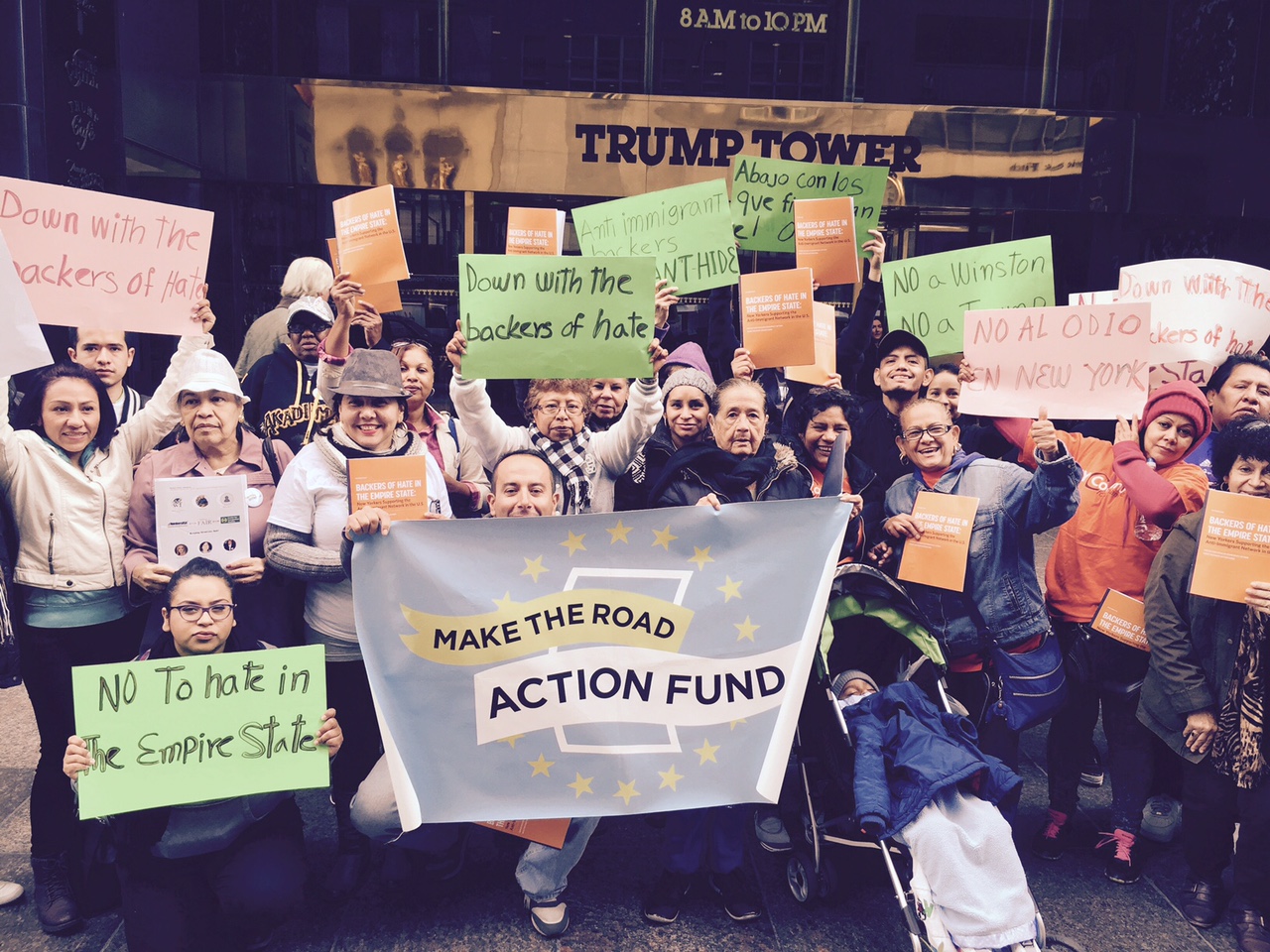
Protesting anti-immigrant messaging
As two of the 4.3 million immigrant members of this state, we, like most of our community, came to New York City with high hopes of acceptance and opportunity. And we love our city. We love how diverse it is, how progressive its values are, and how we have so much opportunity to work together to identify problems and fight for solutions.
One thing we do not love, however, is that there is a group of wealthy New Yorkers working against our immigrant communities to make us feel unwelcome and to separate our families.
As a new report, "Backers of Hate in the Empire State" (which the organizations to which we belong produced with the Center for Popular Democracy Action) has revealed, there is a group of wealthy New Yorkers who are using their millions and elite networks to fund and support the anti-immigrant movement in this country. And the anti-immigrant rhetoric and organizing they are behind is now tragically seeping into our nation's political arena.
That's why, this week, more than 50 immigrants like us joined together recently to protest in midtown Manhattan to call out the backers of hate. These organizations and individuals work together to create an irrational fear of immigrants and they work in favor of anti-immigrant policy. Individuals like Barbara Winston, beneficiary of the Winston gem fortune, have supported anti-immigrant groups for years, and now candidates like Donald Trump and Carly Fiorina are following this lead.
The rhetoric of Trump and other Republicans reflects the hate and lies of these groups. And the same is true for policy. Like anti-immigration groups such as the Federation for American Reform (listed as a hate group by the Southern Poverty Law Center), Keeping Identities Safe, the Center for Immigration Studies, and NumbersUSA, leading GOP candidates oppose immigration relief and a path to citizenship for undocumented immigrants, and they want to get rid of birthright citizenship.
Most New Yorkers disagree with these extreme views, and that's why we're fighting back. We first picketed outside a jewelry store owned by members of the Winston family, and then marched and continued to rally outside of Trump Tower. Our march traced the dangerous connections between the backers of hate in New York State and the toxic conversation around immigration that Republican candidates have launched. This followed several other protests against Mr. Trump himself, at which immigrant New Yorkers have directly confronted him for his anti-immigrant positions.
It's time for the millionaires and billionaires who are using their resources to back anti-immigrant movements to stop and instead use their money and energy to improve schools for our children and housing for our communities—to create a better future for this nation. But, while they continue their anti-immigrant work, it's critical that politicians, the media, and other organizations cut ties with individuals and organizations who support a hateful, anti-immigrant agenda. New York should be a progressive beacon for our country—not a haven for hate.
***
by Maria Rubio, Make the Road Action Fund, and Elva Meneses, New York Communities for Change.
More NYC Families Will Soon Have Access to Care
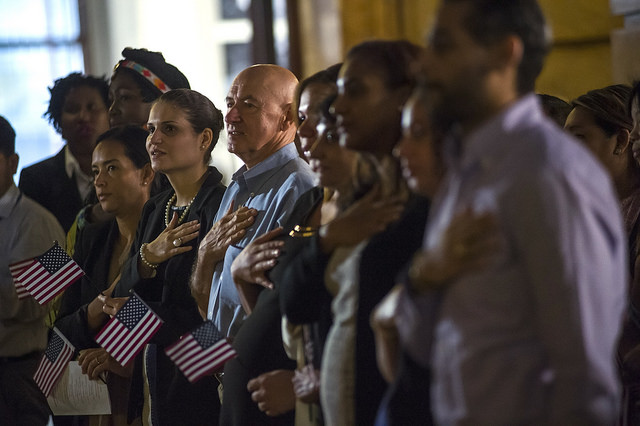
A citizenship ceremony (photo: Ed Reed, Mayor's Office)
New York City's new plan will expand access to care for immigrants across the City
Access to health care is on the rise all across New York City, thanks to federal, state, and city efforts over the last few years.
For example, the latest data show that the number of people who are uninsured dropped 34 percent from 2013 to 2014. That's the good news. The bad news is that many of the remaining uninsured New Yorkers still face daunting barriers to access basic care because of their immigration status or because they don't yet speak English fluently. Indeed, during the congressional debates on the Affordable Care Act, immigrants were treated as the "poison pill" for the legislation, and during debates on immigration reform, health care coverage is similarly sidelined.
We are working to change that dynamic at the local level. With Mayor de Blasio's new plan to improve immigrant access to health care, we are creating a more equitable city. Over the coming months, we will launch the Direct Access project, to explore an affordable system that will provide comprehensive primary and preventive care to immigrants who are ineligible for support under the Affordable Care Act. This project's success will serve as the basis for a more inclusive health care system, including families in our city without access to insurance.
Direct Access is a recommendation of the Mayor's Task Force on Immigrant Health Care Access, a group of City government officials, community advocates, health care professionals, hospital administrators, and public health experts. The Task Force's recommendations acknowledge that many immigrants face unique struggles in accessing care. Many who do not yet have full English proficiency have difficulty finding help in their language. Some encounter a health care system that seems dauntingly unfamiliar. Others find themselves excluded from access to care due to our broken federal immigration system's outdated rules and the failure of multiple attempts at federal reform.
These barriers mean that far too many of our fellow New Yorkers are relegated to a second-class health care system in which they must forgo basic medical care such as check-ups, cancer screening, and chronic care management. Instead they are forced to rely on inefficient emergency room visits and overburdened neighborhood providers, with little to no opportunity for follow-up care. This means that our immigrant family members and neighbors often do not get sufficient basic health care, resulting in missed workdays and unnecessary illness, and a cost that we all share.
The Affordable Care Act, passed in 2010, has helped to solve these problems for millions of Americans. It has expanded access to health care across the country, providing support to nearly all low-income and moderate-income Americans to get health insurance.
But that qualifier—"nearly all"—makes a big difference in our diverse city. According to our analysis, as many as 345,000 uninsured New York City residents who live, work, and raise their families here will remain uninsured because they are ineligible for help under the Affordable Care Act due solely to their immigration status. That is more people than the entire population of St. Louis. Much, perhaps most, of this population would benefit from proposed immigration reforms or the President's November 2014 executive actions. However, all of those measures have been held up in congressional committees or in the courts, victim to political calculations.
We cannot wait for others, in D.C. or Albany, to solve this problem for us. The health and safety of our residents is ultimately our responsibility, and the Mayor's plan represents a bold step forward—the first effort in the country since the implementation of the Affordable Care Act to grow immigrant health care access.
The Mayor's new immigrant health effort is the first step towards a more inclusive health care system. This will strengthen our health care system, our immigrant communities, and our city as a whole.
***
by Nisha Agarwal, Commissioner, NYC Mayor's Office of Immigrant Affairs. On Twitter at @NYCImmigrants.
***
Have an op-ed idea or submission for Gotham Gazette? E-mail editor Ben Max: This email address is being protected from spambots. You need JavaScript enabled to view it.
New York’s Much-Needed New Task Force to Combat Worker Exploitation
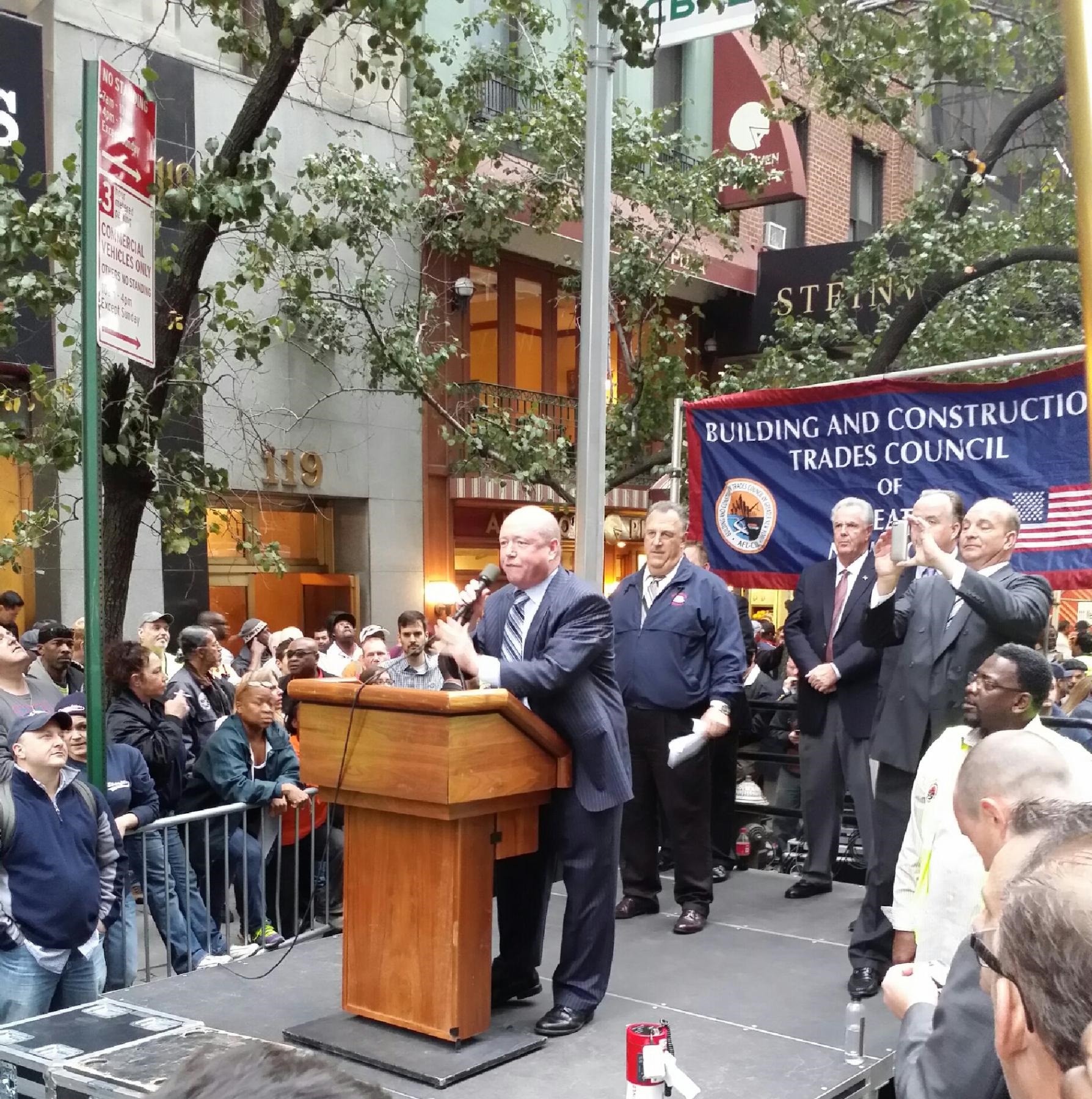
Pat Dolan, the author, at a rally
Governor Andrew Cuomo has just announced an initiative to combat worker exploitation in New York, including investigations focused on employers who are serial offenders, along with the creation of a hotline for reporting worker abuse.
At the first public meeting of the New York Task Force to Combat Worker Exploitation, on October 14, abused workers came forward to give firsthand accounts of living lives in virtual serfdom for employers giving little consideration towards abiding by our state laws, safety or wage mandates.
The ten-agency task force will coordinate data collection, investigations, prosecutions, and compliance, as well as outreach and education with workers and employers, made possible with a $700,000 state allocation.
The findings will shed light on the widespread mistreatment of workers, especially within New York's construction industry, which accounts for less than four percent of statewide employment but 20 percent of the state's occupational fatalities. 3
At the first public hearing, five workers testified about abuses they have suffered on their worksites including racial discrimination, sexual harassment, wage theft, assault, and lack of worker's compensation for when they are injured on the job.
"It's just an abusive system that's going on around here," said Carrol Turner, a non-union construction worker, originally from the island of Jamaica, who discussed repeated instances of wage theft among his co-workers. "You don't have the slightest idea what's going on, especially in the non-union construction world. You have to live it to tell what's going on."
In his more than 13 years with his employer, Mr. Turner testified that he never received safety or industry training and admitted many of his co-workers had been injured on the job. He recalled an instance when his supervisor threatened to fire him if he didn't return to work immediately after receiving an on-the-job injury to one of his fingers that necessitated medical treatment.
According to the U.S. Labor Department's report, Adding Inequality to Injury: The Costs of Failing to Protect Workers on the Job, it is estimated that worker's compensation covers only 21 percent of workplace injury and illnesses. Costs are then primarily footed by employees, their families, and their private health insurance (63 percent), while taxpayers are socked with 16 percent of the tab. But what if your employer provides no healthcare coverage, as is the case with many of these workers?
When asked by a Task Force committee member if his workplace displayed information regarding worker's compensation, Mr. Turner responded, "Plenty of us don't even have an idea there is a thing called worker's compensation."
In construction, falls are the most common cause of serious workplace injuries and comprise half of fatalities in New York State. This occurs in spite of federally-mandated rules requiring safety equipment on worksites including harnesses and safety lines, nets, guard and stair rails. In 2012, 79 percent of fatal fall accidents occurred at non-union construction sites and 60 percent of victims were immigrant and/or Latino, according to the New York Committee for Occupational Safety & Health (NYCOSH).
Another non-union construction worker, Carlos, testified with only his first name, fearing vengeance from his employer after coming forward with stories of assault and wage theft. During Hurricane Sandy, he worked for a contractor at a federal building for 12-14 hours per day without ever seeing a dime. "When you complained about that, they would retaliate against you," he said. The punishment? Taking employees off the work schedule for days, even weeks at a time.
These are some of many tactics used to threaten and intimidate employees in New York's growing and seedy underground construction economy. Those who testified told of scraping by on wages as little as $5 per hour while working 50-60 hour weeks, with no healthcare protection should they become sick or seriously injured on their job site. Many are kept silent by the threat of losing their meager earnings, which can be the difference in providing a hot meal for their families or making rent payments.
The governor's new effort to battle rampant worker exploitation should not be a brief, formulaic exercise. When it is becoming more the norm for workers across our city to be forced to work on dangerous construction sites ten or 20 stories above street level without basic safety gear or training, or perhaps earning half of minimum wage, it's truly time to reexamine what our priorities are. The Governor's Task Force to Combat Worker Exploitation is welcome and necessary.
***
Patrick Dolan Jr. is the President of the 8,200-member Steamfitters Local Union 638. Members of Steamfitters Local 638 install and maintain high-efficiency, state-of-the-art heating, air conditioning, ventilation, fire-suppression and sprinkler systems in commercial, residential and industrial buildings in New York City.
New York Community Colleges Desperately Need Comprehensive Investment
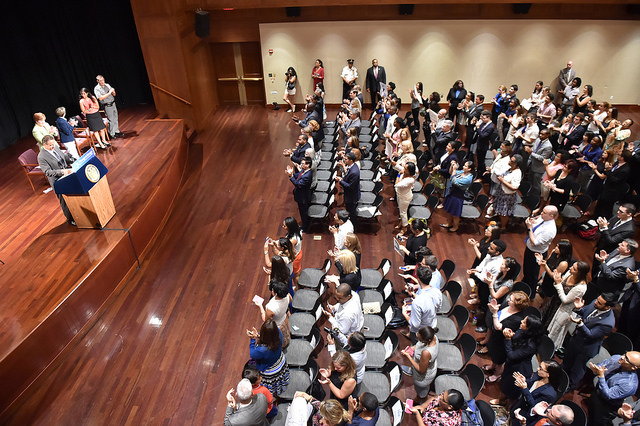
Gov. Cuomo (Office of the Governor - Kevin P. Coughlin)
Governor Cuomo’s leaked plan to make community colleges in New York tuition-free, potentially aligning with President Obama’s America’s College Promise initiative, is an exciting step towards reinvesting in higher education after years of flat-lined funding and tuition hikes. This thinking, if it indeed means increasing our state’s investments in higher education, reflects an awakening around the role that community colleges play in the fabric of society and the future of our economy.
As it currently stands, insufficient state support for higher education in New York is failing students and families. Funding is down seven percent since the Great Recession, and a necessary “Maintenance of Effort” bill passed by the Senate and Assembly forcing the Governor to fund mandatory costs for SUNY and CUNY is on the Governor’s desk with an uncertain future.
What’s more, state support makes up only about a quarter of total community college revenue – leaving students to pay more in tuition, which is among the highest in the country. And at the same time that tuition at our community colleges has increased by $735 over the last 10 years, the Tuition Assistance Program (TAP) - our state’s need-based aid program, not available to part-time students - has only increased by $165 during that same time.
Indeed, increased investment by the state would mark a drastic and much-needed shift from burdening students and families with tuition hikes throughout the Great Recession, and a smart move that would renew our commitment to boosting the take home pay of hard-working New Yorkers.
Average earnings for full-time workers with an associate’s degree are nearly a third higher than earnings for those with only a high school diploma, not to mention that more educated people have additional opportunities to ascend the economic ladder.
But economic prosperity isn’t just good for the workers who are lucky enough to achieve it; it’s good for our state as a whole. It’s estimated that New Yorkers with an associate’s degree will contribute more than $35,000 in state taxes and a New Yorker with a bachelor’s degree will contribute more than $60,000 in state taxes throughout their lifetime. With 330,000 enrollees in the CUNY and SUNY community college system, that means an impressive return on investment.
The President’s initial vision for creating a federal free community college plan is understood to be a first-dollar contribution that pays tuition and fees up front, leaving any remaining federal Pell Grants to cover expenses like textbooks and other living expenses. For context, last year more than 160,000 New York State students received $160 million worth of federal Pell Grants, relying on both state and federal investments to cover not just tuition and other costs of attending school.
A state-federal partnership such as the one described by the Obama Administration (but that has stalled in Congress) could be crafted in a way that gives a federal match encouraging states to invest more and provide first-dollar support, making much-needed increased investment.
If a state pursues a free community college plan poorly, however, it could merely repackage its current investments to cover whatever tuition that the Pell grant (or any other future federal match) does not cover, or to make tuition free but reduce investments in critical need-based aid that help cover the full cost of going to school. That’s a direction that policymakers here should steer clear from.
As we head into the next legislative session in Albany, one thing is clear: we need to act quickly, and not point to the gridlock in Washington as a reason to throw up our hands, say we tried, but ultimately leave New Yorkers further behind.
Even with no additional matching federal dollars forthcoming anytime soon, the governor and other state policymakers can and should lead on this vision around committing new investments to community college students. Governor Cuomo can start with his upcoming executive budget proposal due in late January.
With the governor talking about an initial $500 million investment, and policymakers such as Assemblymember James Skoufis talking about a $2 billion “TuitionFreeNY” bill to provide free tuition to all SUNY and CUNY students, the time has come for New York State to put forward a comprehensive solution to address the needs of the state’s grossly under-resourced community college system and lead the country in creating a universally accessible public higher education opportunity.
In the early 1890s, the Committee of Ten, an elite group of academics and bureaucrats, found that four additional years (what we know as high school) of public education for every American student was necessary. It’s fitting that 125 years later we are having the same conversation to better fit our institutions to the needs of today’s workforce. The additional investment of $500 million, with or without federal matching dollars, is a step towards leading the way in what it means to value and leverage public education in the 21st century.
***
Kevin Stump is the Northeast Director for Young Invincibles (YI), an advocacy and policy organization working on higher education, health, and jobs issues impacting 18-34 year olds. YI is also a part of President Obama's College Promise Task Force. On Twitter @KevinStump and @YoungInvincible.
***
Have an op-ed idea or submission for Gotham Gazette? E-mail editor Ben Max: This email address is being protected from spambots. You need JavaScript enabled to view it.
In Schools and at Home, We Must Talk to Young People About Sex
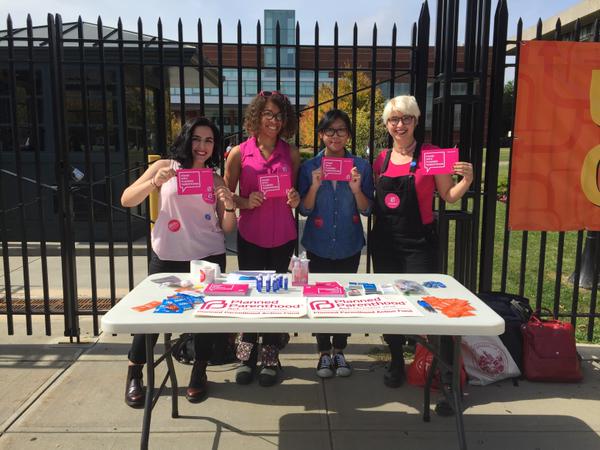
PPNYC volunteers (photo: @PPNYCAction)
When I heard Salt-n-Pepa's song "Let's Talk About Sex" as a young person in the 1990s, it stirred my interest in the subject. I remember coming home and asking my mother about sex, and receiving responses that left me feeling frustrated.
I wasn't getting my questions answered in school either. Sex ed did not go into detail about body image or the emotional connection that came with experiencing sexuality. Unfortunately, in New York City many young people still aren't getting adequate information about sexual health or relationships at school. Like me two decades ago, many aren't getting this information from their parents or caregivers either. Today, young people are often left unequipped in a world filled with distorted sexual messages everywhere on social media, in advertisements, on TV, and elsewhere.
That's why it's so important that, as a city, we prioritize comprehensive, age-appropriate sex ed for all students, kindergarten through 12th grade.
It's also why, as a parent, I make a point to let my children know they can always come to me with questions about sex and sexuality, and I make sure they have accurate information and skills to make healthy decisions. I also joined Planned Parenthood of New York City's Adult Role Model team to educate other parents about how to talk to their kids about sex. Because so many parents are uncomfortable, the program helps provide them with guidance to start what should become an ongoing conversation.
My parents migrated to this country from the Caribbean, and in their culture, sex was not discussed in detail, especially with daughters. It was a brief topic of doom discussed when a girl began menstruating because then there was fear that she could end up pregnant. Girls were typically warned that if they had sex before marriage and became pregnant, the young man was likely to leave, which meant raising the child alone.
I was left on my own, with myths and misinformed answers from my friends, to figure out sexuality. Had my parents felt comfortable and had accurate information about sexuality, or had I learned much-needed information in the New York City school system, I believe my sexual experiences would have been filled with fewer heartbreaks and less gloom.
When I gave birth to my children, I vowed to educate and enlighten them on sexuality because I did not want them to go through similar experiences. When my daughter started middle school, I had questions about what exactly to tell her about sexuality. One day, she came home with a flyer for a workshop hosted by Planned Parenthood of New York City about sexuality and how parents could have these conversations with their children. I was elated - I went to the workshop eager and left equipped with the information and skills to talk more adequately with my children.
I learned that it was OK to give my children my values and that sexuality is more than just sex. I also learned how important it is for parents to have accurate information. In no way was I going to leave it up to the media, or my children's friends. Information about sex needs to come from me, I decided.
The next day I began educating my children, and put them at ease so they could come to me with questions. It was not just a one-time discussion or an accusatory one; it was from and full of love and respect for my children.
So then it began. I became their "go to" person for accurate messages and information about sex and sexuality. When my son was in middle school, he received a sex ed class. When the teacher described the reproductive systems, his peers were "oohing" and "ahhing." He said that he was so comfortable because he already received education about sexuality from his mom. In my head I was doing flips and shouting for joy.
Today, I go to various schools and communities, and I'm surprised that some parents are still not having these important conversations with their children. My children tell me stories about their friends and peers not having someone they can trust to talk to about sexuality.
So let's talk about sex—both in schools and at home. Who do you want your children to learn values from, if not from you? Would you want your child to engage in sexual activities with a partner out of fear or in ignorance? Would you want your child to engage in unprotected sex because they don't know any better?
It's heartbreaking that so many students still aren't learning these essential lessons at home or at school. We must prioritize sex ed in city schools, and encourage parents and the caring adults in the lives of youth to talk to young people about sexuality and sexual health early and often.
***
Marsha Blackman is an Adult Role Model with Planned Parenthood of New York City. Find Planned Parenthood on Twitter @PPNYCAction.
***
Have an op-ed idea or submission for Gotham Gazette? E-mail editor Ben Max: This email address is being protected from spambots. You need JavaScript enabled to view it.




